High-Precision Low-Cost Mid-Infrared Photoacoustic Gas Sensor Using Aspherical Beam Shaping for Rapidly Measuring Greenhouse Gases
Abstract
1. Introduction
2. Theoretical Analysis
3. Simulation
3.1. Simulation of Infrared Blackbody Radiation Source
3.2. Design of Aspherical Optical Beam Shaping
4. Experiment Details
4.1. Absorption Bands Selection of Gases
4.2. Experimental Setup
5. Results and Discussion
5.1. Gas-Sensing Measurement
5.2. Water Vapor Crosstalk Testing and Analysis
5.3. Continuous Monitoring of CO2 and CH4
6. Conclusions
Author Contributions
Funding
Institutional Review Board Statement
Informed Consent Statement
Data Availability Statement
Conflicts of Interest
References
- Fu, L.; You, S.; Li, G.; Fan, Z. Enhancing methane sensing with NDIR technology: Current trends and future prospects. Rev. Anal. Chem. 2023, 42, 20230062. [Google Scholar] [CrossRef]
- Thorpe, M.J.; Moll, K.D.; Jones, R.J.; Safdi, B.; Ye, J. Broadband cavity ringdown spectroscopy for sensitive and rapid molecular detection. Science 2006, 311, 1595–1599. [Google Scholar] [CrossRef] [PubMed]
- Barouch, G.; Clairotte, M. Fourier transform infrared (FTIR) spectroscopy for measurements of vehicle exhaust emissions: A review. Appl. Sci. 2021, 11, 7416. [Google Scholar] [CrossRef]
- Lin, S.; Chang, J.; Sun, J.; Xu, P. Improvement of the detection sensitivity for tunable diode laser absorption spectroscopy: A review. Front. Phys. 2022, 10, 853966. [Google Scholar] [CrossRef]
- Li, J.; Yu, B.; Zhao, W.; Chen, W. A review of signal enhancement and noise reduction techniques for tunable diode laser absorption spectroscopy. Appl. Spectrosc. Rev. 2014, 49, 666–691. [Google Scholar] [CrossRef]
- Picqué, N.; Hänsch, T.W. Frequency comb spectroscopy. Nat. Photonics 2019, 13, 146–157. [Google Scholar] [CrossRef]
- Fathy, A.; Sabry, Y.M.; Hunter, I.W.; Khalil, D.; Bourouina, T. Direct absorption and photoacoustic spectroscopy for gas sensing and analysis: A critical review. Laser Photonics Rev. 2022, 16, 2100556. [Google Scholar] [CrossRef]
- Yang, T.; Chen, W.; Wang, P. A review of all-optical photoacoustic spectroscopy as a gas sensing method. Appl. Spectrosc. Rev. 2020, 56, 143–170. [Google Scholar] [CrossRef]
- Zhu, Z.; Liu, Y.; Yang, J.; Hu, G. A review of single-cavity dual-comb laser and its application in spectroscopy. Spectrosc. Spectr. Anal. 2021, 41, 3321–3330. [Google Scholar]
- Elia, A.; Lugarà, P.M.; Di Franco, C.; Spagnolo, V. Photoacoustic techniques for trace gas sensing based on semiconductor laser sources. Sensors 2009, 9, 9616–9628. [Google Scholar] [CrossRef]
- Ma, Y. Review of recent advances in QEPAS-based trace gas sensing. Appl. Sci. 2018, 8, 1822. [Google Scholar] [CrossRef]
- Kreuzer, L.B. Ultralow gas concentration infrared absorption spectroscopy. J. Appl. Phys. 1971, 42, 2934–2943. [Google Scholar] [CrossRef]
- Harren, F.J.M.; Reuss, J.; Woltering, E.J.; Bicanic, D.D. Photoacoustic measurements of agriculturally interesting gases and detection of C2H4 below the PPB level. Appl. Spectrosc. 1990, 44, 1360–1368. [Google Scholar] [CrossRef]
- McNaghten, E.D.; Grant, K.A.; Parkes, A.M.; Martin, P.A. Simultaneous detection of trace gases using multiplexed tunable diode lasers and a photoacoustic cell containing a cantilever microphone. Appl. Phys. B 2012, 107, 861–871. [Google Scholar] [CrossRef]
- Rey, J.M.; Sigrist, M.W. Non-dispersive sensing scheme based on mid-infrared LED and differential mode excitation photoacoustic spectroscopy. Photoacoustics 2023, 29, 100455. [Google Scholar] [CrossRef] [PubMed]
- Zha, S.; Ma, H.; Zha, C.; Chen, J.; Huang, X.; Liu, K.; Zhan, S. Application of broadband photoacoustic spectroscopy in methane concentration detection. Laser Optoelectron. Prog. 2019, 56, 043001. [Google Scholar]
- Kerr, E.L.; Atwood, J.G. The laser illuminated absorptivity spectrophone: A method for measurement of weak absorptivity in gases at laser wavelengths. Appl. Opt. 1968, 5, 915–921. [Google Scholar] [CrossRef] [PubMed]
- Zhang, L.; Liu, L.; Zhang, X.; Yin, X.; Huan, H.; Liu, H. T-type cell mediated photoacoustic spectroscopy for simultaneous detection of multi-component gases based on triple resonance modality. Photoacoustics 2023, 31, 100492. [Google Scholar] [CrossRef] [PubMed]
- Li, Z.; Si, G.; Ning, Z.; Liu, J.; Fang, Y.; Cheng, Z.; Si, B.; Yang, C. Photoacoustic detection of CO2 based on mid-infrared LED. Acta Opt. Sin. 2022, 42, 1330001. [Google Scholar]
- Christensen, J. The Brüel & Kjær photoacoustic transducer system and its physical properties. Tech. Rev. 1990, 1–1990. Available online: https://www.bksv.com/media/doc/TechnicalReview1990-1.pdf (accessed on 22 June 2024).
- Christensen, J. Optical filters and their use with the type 1302 & type 1306 photoacoustic gas monitors. Tech. Rev. 1990, 2–1990. Available online: https://www.bksv.com/media/doc/TechnicalReview1990-2.pdf (accessed on 22 June 2024).
- Chen, K.; Liu, S.; Zhang, B.; Gong, Z.; Chen, Y.; Zhang, M.; Deng, H.; Guo, M.; Ma, F.; Zhu, F.; et al. Highly sensitive photoacoustic multi-gas analyzer combined with mid-infrared broadband source and near-infrared laser. Opt. Lasers Eng. 2020, 124, 105844. [Google Scholar] [CrossRef]
- Qiu, Y.; Fan, Y.; Yan, B.; Wang, Y.; Wu, Y.; Han, Z.; Qi, Y.; Lu, P. Design and experiment of light field shaping system for three-dimensional extended light source used in photoacoustic spectrometer. Acta Phys. Sin. 2021, 70, 204201. [Google Scholar] [CrossRef]
- Xiao, H.; Zhao, J.; Sima, C.; Lu, P.; Long, Y.; Ai, Y.; Zhang, W.; Pan, Y.; Zhang, J.; Liu, D. Ultra-sensitive ppb-level methane detection based on NIR all-optical photoacoustic spectroscopy by using differential fiber-optic microphones with gold-chromium composite nanomembrane. Photoacoustics 2022, 26, 100353. [Google Scholar] [CrossRef]
- Li, T.; Sima, C.; Ai, Y.; Tong, C.; Zhao, J.; Zhao, Z.; Lu, P. Photoacoustic spectroscopy-based ppb-level multi-gas sensor using symmetric multi-resonant cavity photoacoustic cell. Photoacoustics 2023, 32, 100526. [Google Scholar] [CrossRef] [PubMed]
- Yat, H.L.; Rainer, L. Aspheric lenses for terahertz imaging. Opt. Express 2008, 16, 15991–15998. [Google Scholar]
- Gordon, I.E.; Rothman, L.S.; Hargreaves, R.J.; Hashemi, R.; Karlovets, E.V.; Skinner, F.M.; Conway, E.K.; Hill, C.; Kochanov, R.V.; Tan, Y.; et al. The HITRAN2020 molecular spectroscopic database. J. Quant. Spectrosc. Radiat. Transf. 2022, 277, 107949. [Google Scholar]
- Long, G.L.; Winefordner, J.D. Limit of detection: A closer look at the IUPAC definition. Anal. Chem. 1983, 55, 712A–724A. [Google Scholar]
- Wu, H.; Dong, L.; Zheng, H.; Yu, Y.; Ma, W.; Zhang, L.; Yin, W.; Xiao, L.; Jia, S.; Tittel, F.K. Beat frequency quartz-enhanced photoacoustic spectroscopy for fast and calibration-free continuous trace-gas monitoring. Nat. Commun. 2017, 8, 15331. [Google Scholar] [CrossRef] [PubMed]
- Wu, G.; Xing, J.; Gong, Z.; Ma, J.; Fan, Y.; Wu, X.; Wei, P.; Yu, Q.; Liang, M. Single fiber-type double cavity enhanced photoacoustic spectroscopy sensor for trace methane sensing. J. Light. Technol. 2024, 42, 3393–3398. [Google Scholar] [CrossRef]
- Liu, H.; Hu, M.; Chen, X.; Deng, H.; Xu, Z.; Wang, Q.; Li, X.; Kan, R.; Zhang, X. Sensitive detection of CH4 and CO2 using frequency-division-multiplexing based quartz-enhanced photoacoustic spectroscopy. Acta Opt. Sin. 2021, 41, 1430003. [Google Scholar]
- De Palo, R.; Elefante, A.; Biagi, G.; Paciolla, F.; Weih, R.; Villada, V.; Zifarelli, A.; Giglio, M.; Sampaolo, A.; Spagnolo, V.; et al. Quartz-enhanced photoacoustic sensors for detection of eight air pollutants. Adv. Photonics Res. 2023, 4, 2200353. [Google Scholar] [CrossRef]
- Zhang, N.; Srivastava, A.; Li, X.; Li, Y.; Zhou, Z.; Bittner, A.; Zhou, X.; Dehe, A. Design and evaluation of a miniaturized non-resonant photoacoustic CO2 gas sensor with integrated electronics. In Proceedings of the 2023 IEEE SENSORS, Vienna, Austria, 29 October–1 November 2023; pp. 1–4. [Google Scholar]

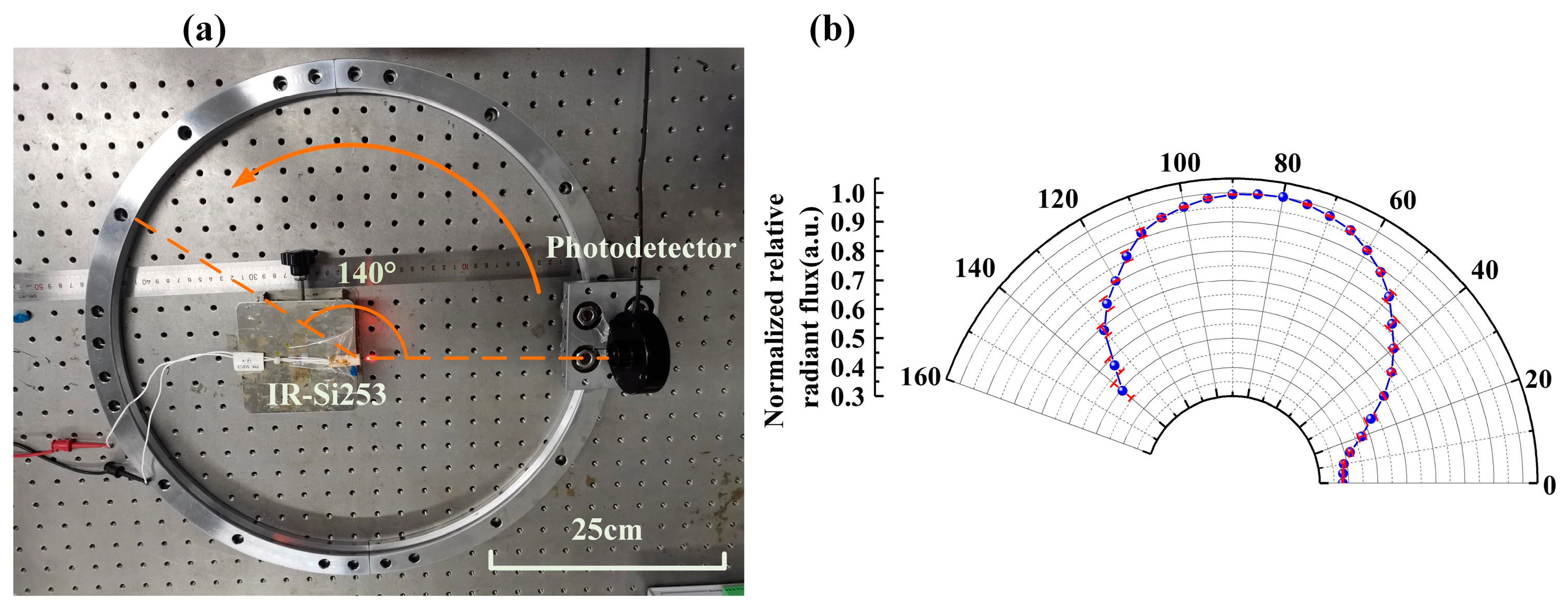





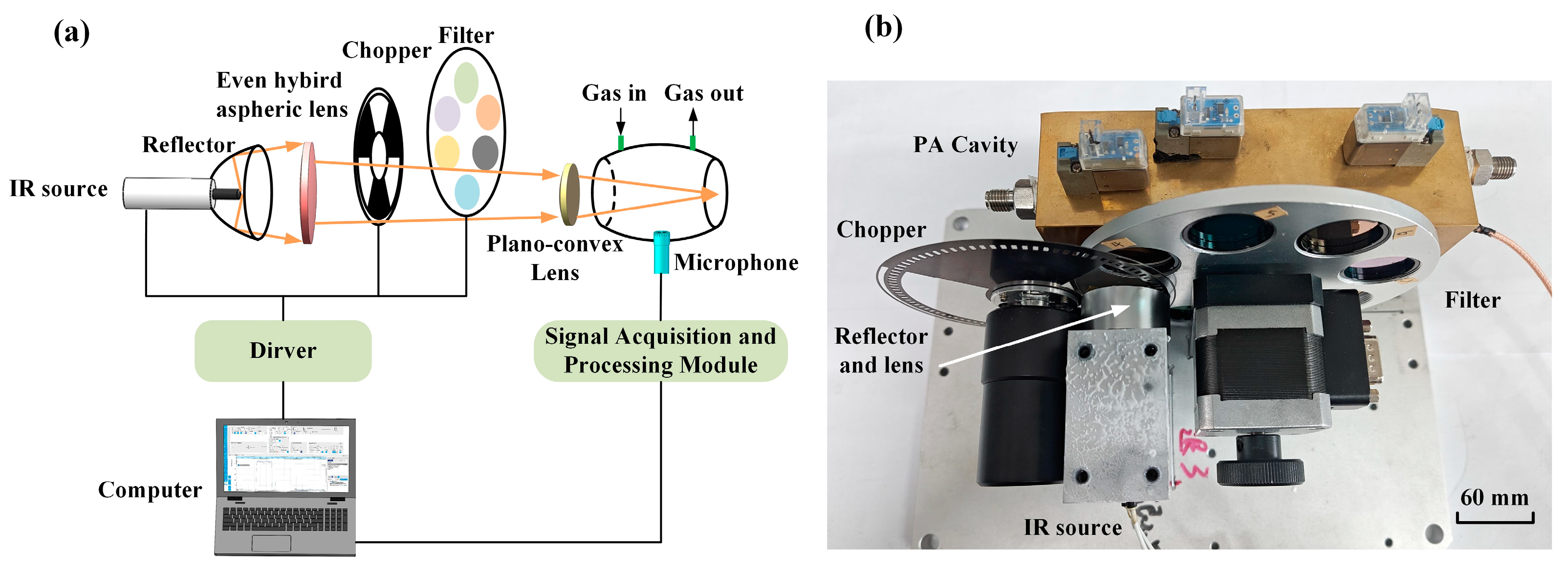

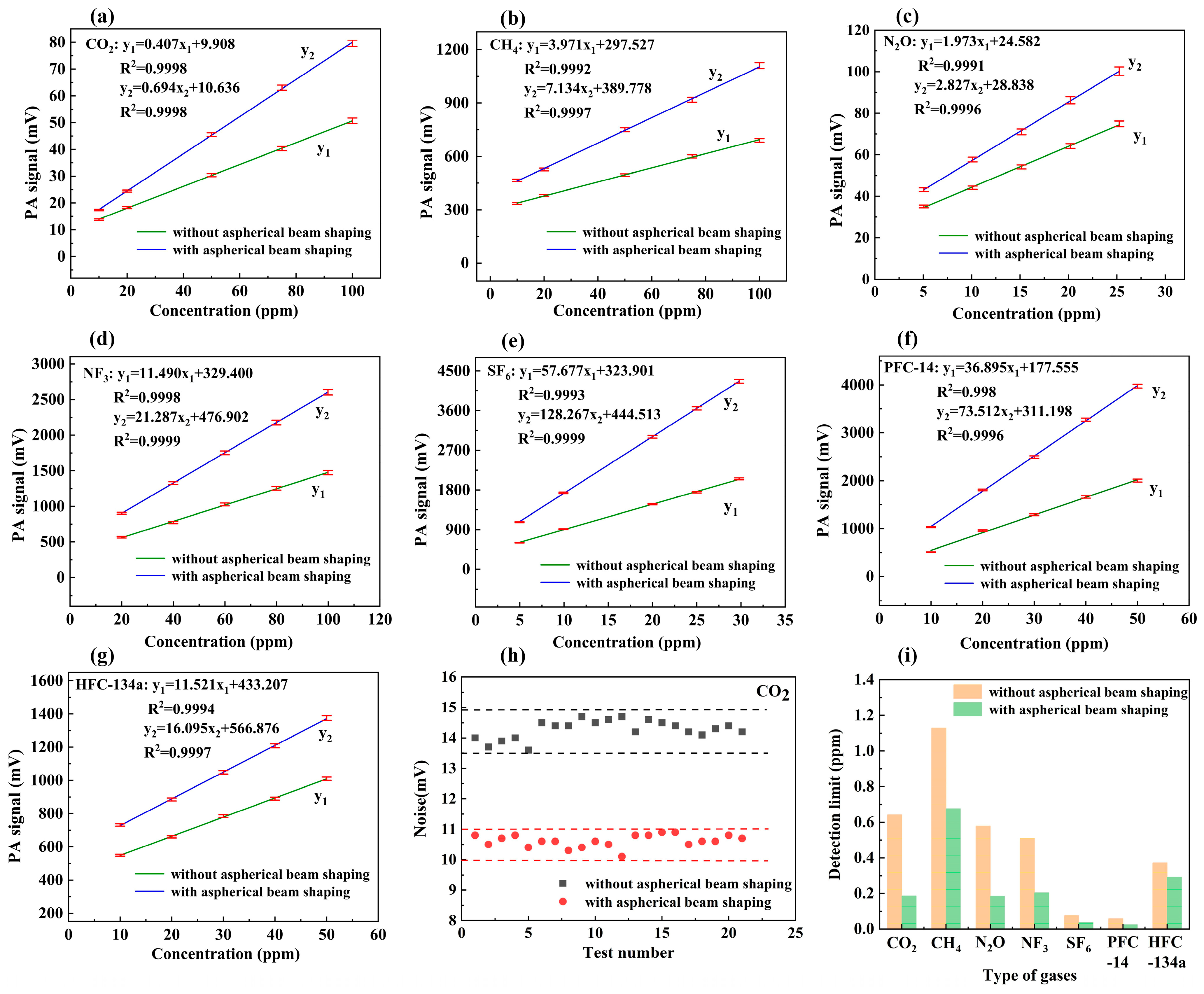
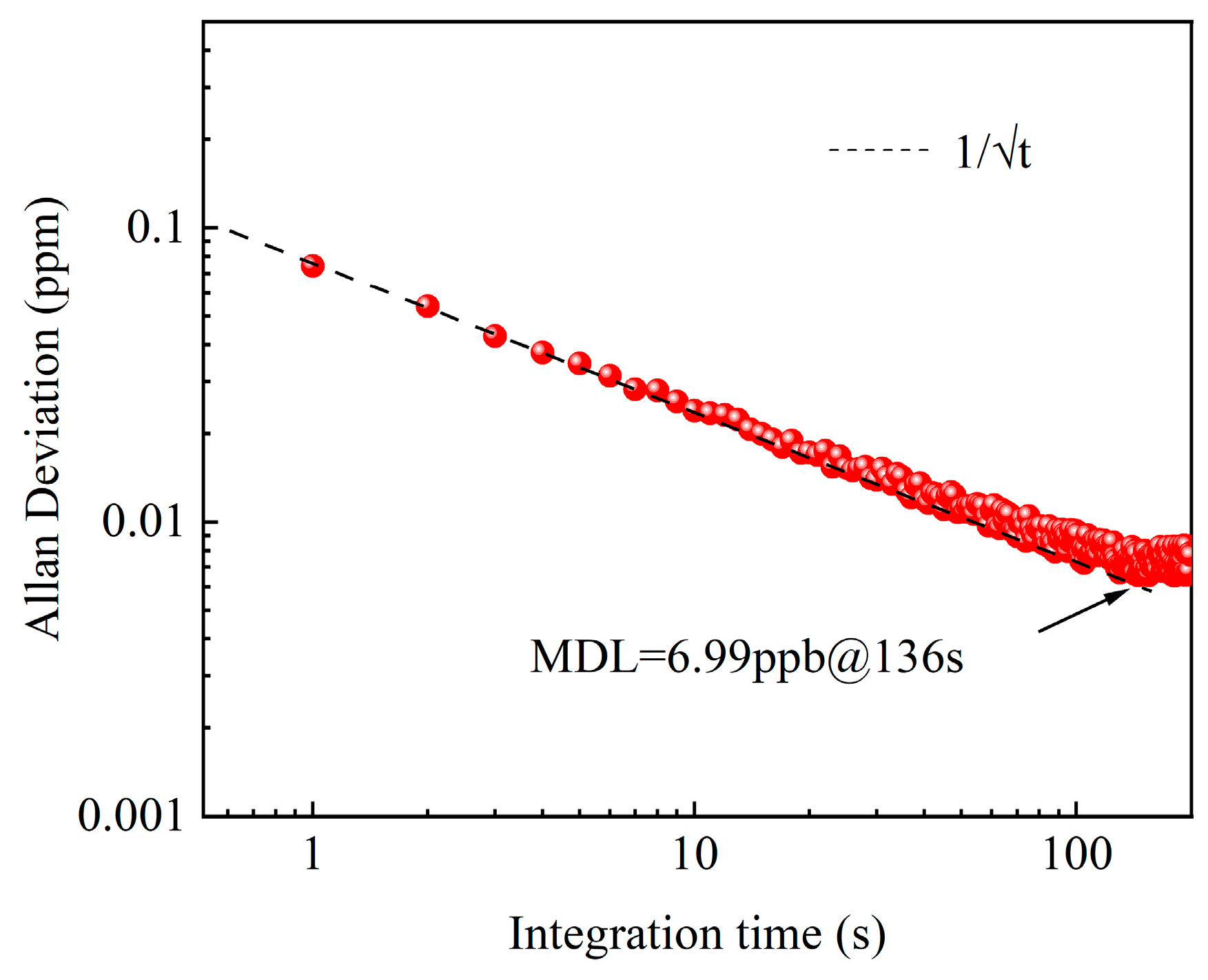


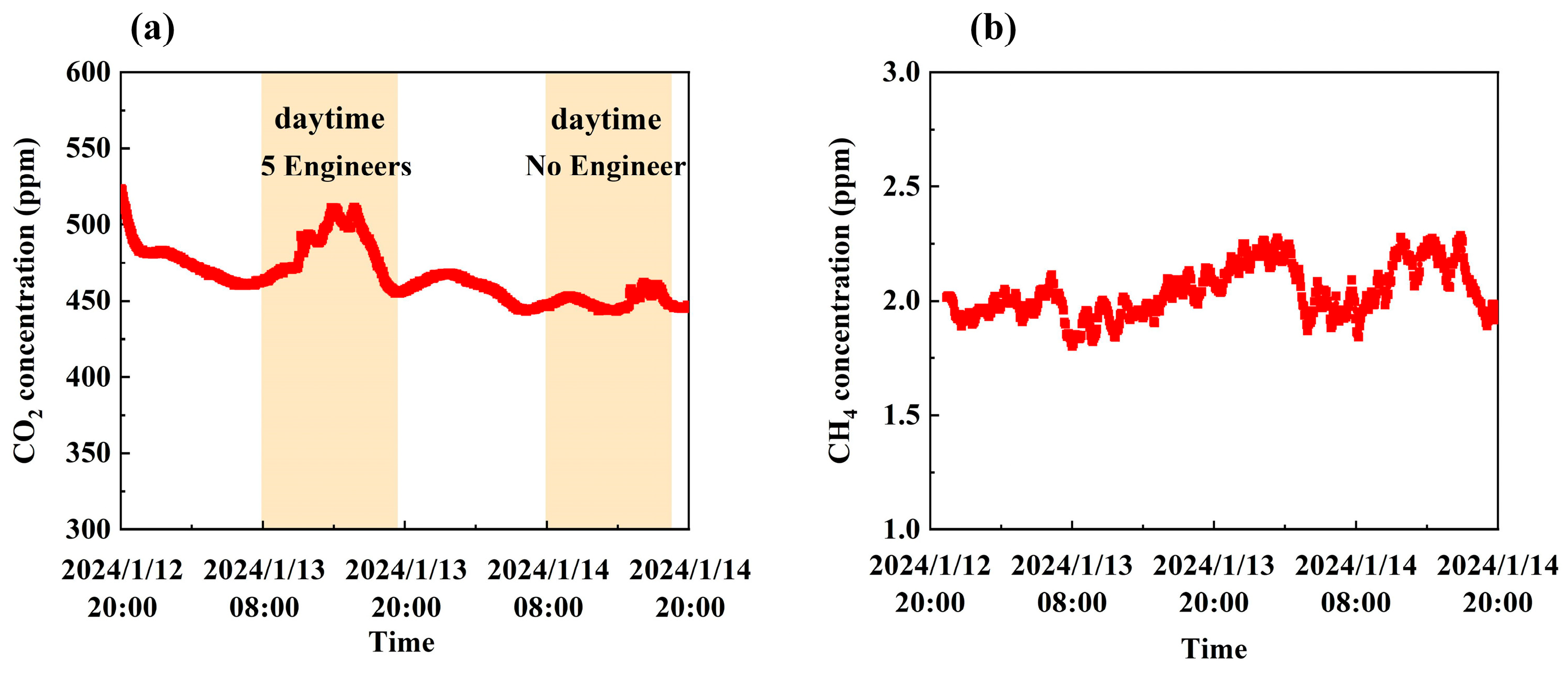
| System | Optical Power at Inlet of PA Cavity (W) | Optical Power at Outlet of PA Cavity (W) | Rnoise (%) | η (%) |
|---|---|---|---|---|
| Without aspherical beam shaping | 1.904 | 0.789 | 58.6 | 41.44 |
| With aspherical beam shaping | 1.132 | 1.031 | 8.9 | 91.08 |
| Gas | Central Wavelength (nm) | Bandwidth (nm) |
|---|---|---|
| CO2 | 4260 | 195 |
| CH4 | 3250 | 95 |
| N2O | 4600 | 190 |
| SF6 | 10,600 | 1060 |
| NF3 | 10,800 | 190 |
| PFC-14 | 7800 | 450 |
| HFC-134a | 8400 | 250 |
| H2O | 6080 | 200 |
| Technology | Wavelength Region | Integration Time (s) | MDL (ppb) | Light Source | Reference |
|---|---|---|---|---|---|
| SFDCE-PAS | Mid-infrared | 100 | CH4 (1130) | DFB la-ser | [30] |
| QEPAS | Mid-infrared | 450 | CH4 (580), CO2 (1320) | DFB laser | [31] |
| QEPAS | Mid-infrared | 0.1 | CO2 (800), N2O (230) | ICL and QCL laser | [32] |
| Non-resonant PAS | Mid-infrared | 330 | CO2 (2200) | Infrared radiation source | [33] |
| Non-resonant PAS | Mid-infrared | 1 | CO2 (73), CH4 (267), N2O (72), NF3 (81), SF6 (14), PFC-14 (9), HFC-134a (115) | Infrared radiation source | This paper |
Disclaimer/Publisher’s Note: The statements, opinions and data contained in all publications are solely those of the individual author(s) and contributor(s) and not of MDPI and/or the editor(s). MDPI and/or the editor(s) disclaim responsibility for any injury to people or property resulting from any ideas, methods, instructions or products referred to in the content. |
© 2024 by the authors. Licensee MDPI, Basel, Switzerland. This article is an open access article distributed under the terms and conditions of the Creative Commons Attribution (CC BY) license (https://creativecommons.org/licenses/by/4.0/).
Share and Cite
Hu, Q.; Ai, Y.; Sima, C.; Sun, Y.; Feng, Z.; Li, T.; Tong, C.; Cao, X.; Wang, W.; Fan, R.; et al. High-Precision Low-Cost Mid-Infrared Photoacoustic Gas Sensor Using Aspherical Beam Shaping for Rapidly Measuring Greenhouse Gases. Photonics 2024, 11, 590. https://doi.org/10.3390/photonics11070590
Hu Q, Ai Y, Sima C, Sun Y, Feng Z, Li T, Tong C, Cao X, Wang W, Fan R, et al. High-Precision Low-Cost Mid-Infrared Photoacoustic Gas Sensor Using Aspherical Beam Shaping for Rapidly Measuring Greenhouse Gases. Photonics. 2024; 11(7):590. https://doi.org/10.3390/photonics11070590
Chicago/Turabian StyleHu, Qingping, Yan Ai, Chaotan Sima, Yu Sun, Zhiyu Feng, Tailin Li, Chen Tong, Xiaohong Cao, Wenzhe Wang, Runze Fan, and et al. 2024. "High-Precision Low-Cost Mid-Infrared Photoacoustic Gas Sensor Using Aspherical Beam Shaping for Rapidly Measuring Greenhouse Gases" Photonics 11, no. 7: 590. https://doi.org/10.3390/photonics11070590
APA StyleHu, Q., Ai, Y., Sima, C., Sun, Y., Feng, Z., Li, T., Tong, C., Cao, X., Wang, W., Fan, R., Pan, Y., & Lu, P. (2024). High-Precision Low-Cost Mid-Infrared Photoacoustic Gas Sensor Using Aspherical Beam Shaping for Rapidly Measuring Greenhouse Gases. Photonics, 11(7), 590. https://doi.org/10.3390/photonics11070590






